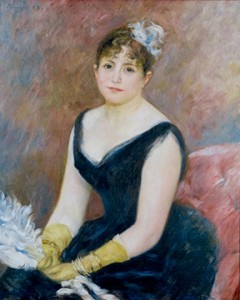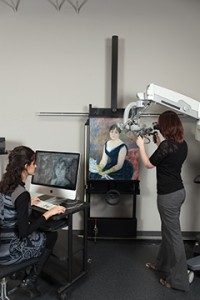The only things these two items have in common is that they are concerned with visual art. and with solving mysteries The first item concerns research by Richard Van Duyne into the nature of the red paint used in one of Renoir’s paintings. A February 14, 2014 news item on Azonano describes some of the art conservation work that Van Duyne’s (nanoish) technology has made possible along with details about this most recent work,
Scientists are using powerful analytical and imaging tools to study artworks from all ages, delving deep below the surface to reveal the process and materials used by some of the world’s greatest artists.
Northwestern University chemist Richard P. Van Duyne, in collaboration with conservation scientists at the Art Institute of Chicago, has been using a scientific method he discovered nearly four decades ago to investigate masterpieces by Pierre-Auguste Renoir, Winslow Homer and Mary Cassatt.
Van Duyne recently identified the chemical components of paint, now partially faded, used by Renoir in his oil painting “Madame Léon Clapisson.” Van Duyne discovered the artist used carmine lake, a brilliant but light-sensitive red pigment, on this colorful canvas. The scientific investigation is the cornerstone of a new exhibition at the Art Institute of Chicago.
The Art Institute of Chicago’s exhibition is called, Renoir’s True Colors: Science Solves a Mystery. being held from Feb. 12, 2014 – April 27, 2014. Here is an image of the Renoir painting in question and an image featuring the equipment being used,
The Feb. 13, 2014 Northwestern University news release (also on EurekAlert) by Megan Fellman, which originated the news item, gives a brief description of Van Duyne’s technique and its impact on conservation at the Art Institute of Chicago (Note: A link has been removed),
To see what the naked eye cannot see, Van Duyne used surface-enhanced Raman spectroscopy (SERS) to uncover details of Renoir’s paint. SERS, discovered by Van Duyne in 1977, is widely recognized as the most sensitive form of spectroscopy capable of identifying molecules.
…
Van Duyne and his colleagues’ detective work informed the production of a new digital visualization of the painting’s original colors by the Art Institute’s conservation department. The re-colorized reproduction and the original painting (presented in a case that offers 360-degree views) can be viewed side by side at the exhibition “Renoir’s True Colors: Science Solves a Mystery” through April 27 [2014] at the Art Institute.
I first wrote about Van Duyne’s technique in my wiki, The NanoTech Mysteries. From the Scientists get artful page (Note: A footnote was removed),
Richard Van Duyne, then a chemist at Northwestern University, developed the technique in 1977. Van Duyne’s technology, based on Raman spectroscopy which has been around since the 1920s, is called surface-enhanced Raman spectroscopy’ or SERS “[and] uses laser light and nanoparticles of precious metals to interact with molecules to show the chemical make-up of a particular dye.”
This next item is about forgery detection. A March 5, 2014 news release on EurekAlert describes the latest developments,
Gallery owners, private collectors, conservators, museums and art dealers face many problems in protecting and evaluating their collections such as determining origin, authenticity and discovery of forgery, as well as conservation issues. Today these problems are more accurately addressed through the application of modern, non-destructive, “hi-tech” techniques.
Dmitry Gavrilov, a PhD student in the Department of Physics at the University of Windsor (Windsor, Canada), along with Dr. Roman Gr. Maev, the Department of Physics Professor at the University of Windsor (Windsor, Canada) and Professor Dr. Darryl Almond of the University of Bath (Bath, UK) have been busy applying modern techniques to this age-old field. Infrared imaging, thermography, spectroscopy, UV fluorescence analysis, and acoustic microscopy are among the innovative approaches they are using to conduct pre-restoration analysis of works of art. Some fascinating results from their applications are published today in the Canadian Journal of Physics.
Since the early 1900s, using infrared imaging in various wave bands, scientists have been able to see what parts of artworks have been retouched or altered and sometimes even reveal the artist’s original sketches beneath layers of the paint. Thermography is a relatively new approach in art analysis that allows for deep subsurface investigation to find defects and past reparations. To a conservator these new methods are key in saving priceless works from further damage.
Gavrilov explains, “We applied new approaches in processing thermographic data, materials spectra data, and also the technique referred to as craquelure pattern analysis. The latter is based on advanced morphological processing of images of surface cracks. These cracks, caused by a number of factors such as structure of canvas, paints and binders used, can uncover important clues on the origins of a painting.”
“Air-coupled acoustic imaging and acoustic microscopy are other innovative approaches which have been developed and introduced into art analysis by our team under supervision of Dr. Roman Gr. Maev. The technique has proven to be extremely sensitive to small layer detachments and allows for the detection of early stages of degradation. It is based on the same principles as medical and industrial ultrasound, namely, the sending a sound wave to the sample and receiving it back. ”
Spectroscopy is a technique that has been useful in the fight against art fraud. It can determine chemical composition of pigments and binders, which is essential information in the hands of an art specialist in revealing fakes. As described in the paper, “…according to the FBI, the value of art fraud, forgery and theft is up to $6 billion per year, which makes it the third most lucrative crime in the world after drug trafficking and the illegal weapons trade.”
One might wonder how these modern applications can be safe for delicate works of art when even flash photography is banned in art galleries. The authors discuss this and other safety concerns, describing both historic and modern-day implications of flash bulbs and exhibit illumination and scientific methods. As the paper concludes, the authors suggest that we can expect that the number of “hi-tech” techniques will only increase. In the future, art experts will likely have a variety of tools to help them solve many of the mysteries hiding beneath the layers.
Here’s a link to and a citation for the paper,
A review of imaging methods in analysis of works of art: Thermographic imaging method in art analysis by D. Gavrilov, R.Gr. Maev, and D.P. Almond. Canadian Journal of Physics, 10.1139/cjp-2013-0128
This paper is open access.

